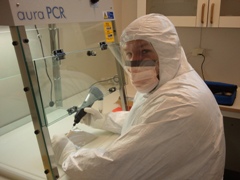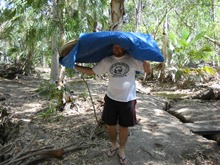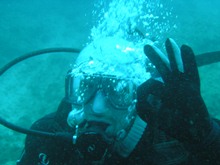I am currently the Head of Molecular Genetics at University of Veterinary Medicine in Vienna and also a Senior Research Fellow at the Molecular Ecology Lab at Flinders University in Adelaide.
I am a highly motivated independent researcher with expertise in molecular ecology and its techniques. My principle research interests lie in exploring the maintenance of adaptive variation in wild populations and, more specifically, the role of habitat variability in driving genetic diversity. A recent extension of my main research focus incorporates how the interplay between reproduction and oxidative stress affects lifespan and ultimately lifetime fitness.
Since completing my PhD in November 2007, I have pursued postdoctoral research projects at the Research Institute of Wildlife Ecology in Vienna, Austria. A major theme has been understanding the immunogenetic basis of individual fitness in brown hares. Further to this I have explored, in collaboration with reproductive biologists and physiologists throughout Europe, the link between mitochondrial function, oxidative stress, and male reproductive success. In a more recent collaboration with the Swedish Museum of Natural History, I have examined ancient DNA samples to reveal the distribution of mtDNA diversity in mountain hares at the end of the last glaciation.
– February 2013 – present
Head of Molecular Genetics, University of Veterinary Medicine, Vienna.
– February 2013 – present
Senior Research Fellow and Adjunct Academic, Molecular Ecology Lab, Flinders University, School of Biological Sciences.
– July 2011 – February 2013
Research Fellow, Flinders University, School of Biological Sciences. My project investigates the effect of changes in climate and habitat on expression patterns of functionally important genes in Australian rainbowfish.
– July 2010 – June 2011
Senior Postdoctoral Researcher, University of Veterinary Medicine Vienna. Projects included: telomere dynamics related to torpor use and cold adaptation in Djungarian hamsters; trade-offs between MHC-related immune response and reproduction in male European brown hares; and the mtDNA basis for reduced sperm function and breeding success in brown hares.
– Feb 2008 – Jun 2010
Postdoctoral Researcher, Research Institute of Wildlife Ecology, Vienna. FWF funded project: “MHC genes and endoparasites in brown hares, Lepus europaeus: a model for understanding the meaning and consequences of immunogenetic diversity for individual fitness in wild living mammals”
– March 2001 – Jan 2003
Research Assistant, Max Planck Institute for Evolutionary Biology Leipzig, Laboratory for Conservation Genetics.
– July 1998 – March 2001
Research Assistant, Griffith University Population Genetics Laboratory
– March 2000 – Dec 2000
Environmental Scientist, Brown & Root Environmental Consultants (casual). Duties involved: conducting fauna surveys and vegetation assessments as required and ground and surface water sampling of project sites.
Current address:
Head of Molecular Genetics
Department of Integrative Biology and Evolution
University of Veterinary Medicine, Vienna
Savoyenstrasse 1a
1160 Vienna, Austria
www.vetmeduni.ac.at/en/konrad-lorenz-institute-of-ethology/about/genetics-lab/


– Smith, S., Bernatchez, L., Beheregaray, L.B. (2013): RNA-seq analysis reveals extensive transcriptional plasticity to temperature stress in a freshwater fish species. BMC Genomics (14) 375-375. doi:10.1186/1471-2164-14-375
– Turbill, C., Ruf, T., Smith, S. and Bieber, C. (2013) Seasonal variation in telomere length of a hibernating rodent. Biology Letters 9 (2), art. No. 1095. doi:10.1098/rsbl.2012.1095
– Schaschl H, Suchentrunk F, Morris DL, Ben Slimen H., Smith S, Arnold W (Submitted) Sex-specific selection for MHC variability in Alpine chamois.
– Drew RAI, Ma J, Smith S, Hughes J (2011) The taxonomy and phylogenetic relationships of species in the Bactrocera musae complex of fruit flies (Diptera: Tephritidae: Dacinae) in Papua New Guinea. Raffles Bulletin of Zoology59(2): 145-162
– Turbill, C, Smith S, Deimel, C, Ruf, T (2011) Daily torpor is associated with telomere length change over winter in Djungarian hamsters. Biology Lettersdoi:10.1098/rsbl.2011.0758
– Smith S, Gouy de Bellocq J, Suchentrunk F, Schaschl H (2011) Evolutionary genetics of MHC class II beta genes in the brown hare, Lepus europaeus. Immunogenetics doi: 10.1007/s00251-011-0539-3
– Smith S, Turbill C, Penn D (2011) Chasing telomeres not red herrings in evolutionary ecology. Heredity. 107: 372-373,doi:10.1038/hdy.2011.14
– Smith S, Gouy de Bellocq J, Mang T, Zeitlhofer C, Hackländer K, Schaschl H, Suchentrunk F (2010) Homozygosity at a class II MHC locus depresses female reproductive ability in European brown hares. Molecular Ecology 19 (19) 4131-4143.
– Smith S., Belov, K. and Hughes, J. (2010) MHC screening for marsupial conservation: extremely low levels of class II diversity indicate population vulnerability for an endangered Australian marsupial. Conservation Genetics 11 (1): 269-278.
– Smith S, Turbill C, Suchentrunk F (2010) Introducing mother’s curse: low male fertility associated with an imported mtDNA haplotype in a captive colony of brown hares. Molecular Ecology 19 (1): 36-43.
– Smith S, Gouy de Bellocq J, Zeitlhofer C, Hackländer K, Duscher G, Suchentrunk F (2009) Is European brown hare fitness related to MHC and microsatellite variability? Mammalian Biology 74 (Supp. 1):23.
– Smith S, McRae P, Hughes J (2009) Faecal DNA analysis enables genetic monitoring of the species recovery program for an arid-dwelling marsupial. Australian Journal of Zoology 57:139-148
– Smith S, Hughes J (2008) Mother’s curse effect in a captive breeding program for an endangered Australian marsupial may reduce population viability. Mammalian Biology 73 (Supp. 1):38.
– Smith S, Hughes J (2008) Microsatellite and mitochondrial DNA variation defines island genetic reservoirs for reintroductions of an endangered Australian marsupial, Perameles bougainville. Conservation Genetics 9:547-557.
– Stratton H, Smith S, Lemckert C (2006) Replacing indicator organisms with real pathogens – optimisation of molecular genetic techniques for detecting pathogens in water. Is it possible? Proceedings of Enviro06; Paper e6413.
– Smith S, Morin PA (2005) Optimal storage conditions for highly dilute DNA samples: A role for trehalose as a preserving agent. Journal of Forensic Sciences 50 (5): 1101-1108.
– Smith S, Aitken N, Schwarz C, Morin PA (2004) Characterisation of 15 single nucleotide polymorphism markers for chimpanzees (Pan troglodytes) Molecular Ecology Notes 4 (3): 348-351.
– Aitken N, Smith S, Schwarz C, Morin PA (2004) Single nucleotide polymorphism (SNP) discovery in mammals: a targeted gene approach. Molecular Ecology 13: 1423-1431.
– Wandeler P, Smith S, Morin PA, Pettifor R A, Funk S M (2003) Patterns of nuclear DNA degeneration over time: a case study in historic teeth samples. Molecular Ecology 12 (4): 1087-1093.
– Smith S, Hughes J, Wardell-Johnson G (2003) High population differentiation and extensive clonality in a rare mallee eucalypt: Eucalyptus curtisii. Conservation Genetics 4: 289-300.
– Smith S, Vigilant L, Morin PA (2002) The effects of sequence length and oligonucleotide mismatches on 5′ exonuclease assay efficiency. Nucleic Acids Research 30 (20): e111.
